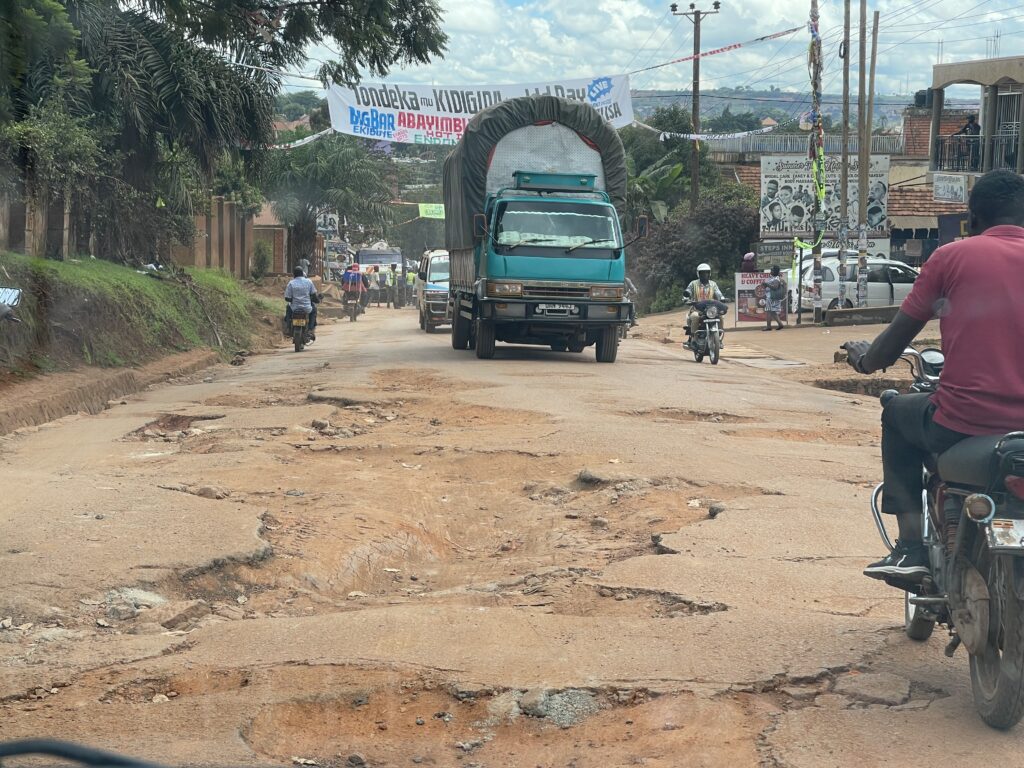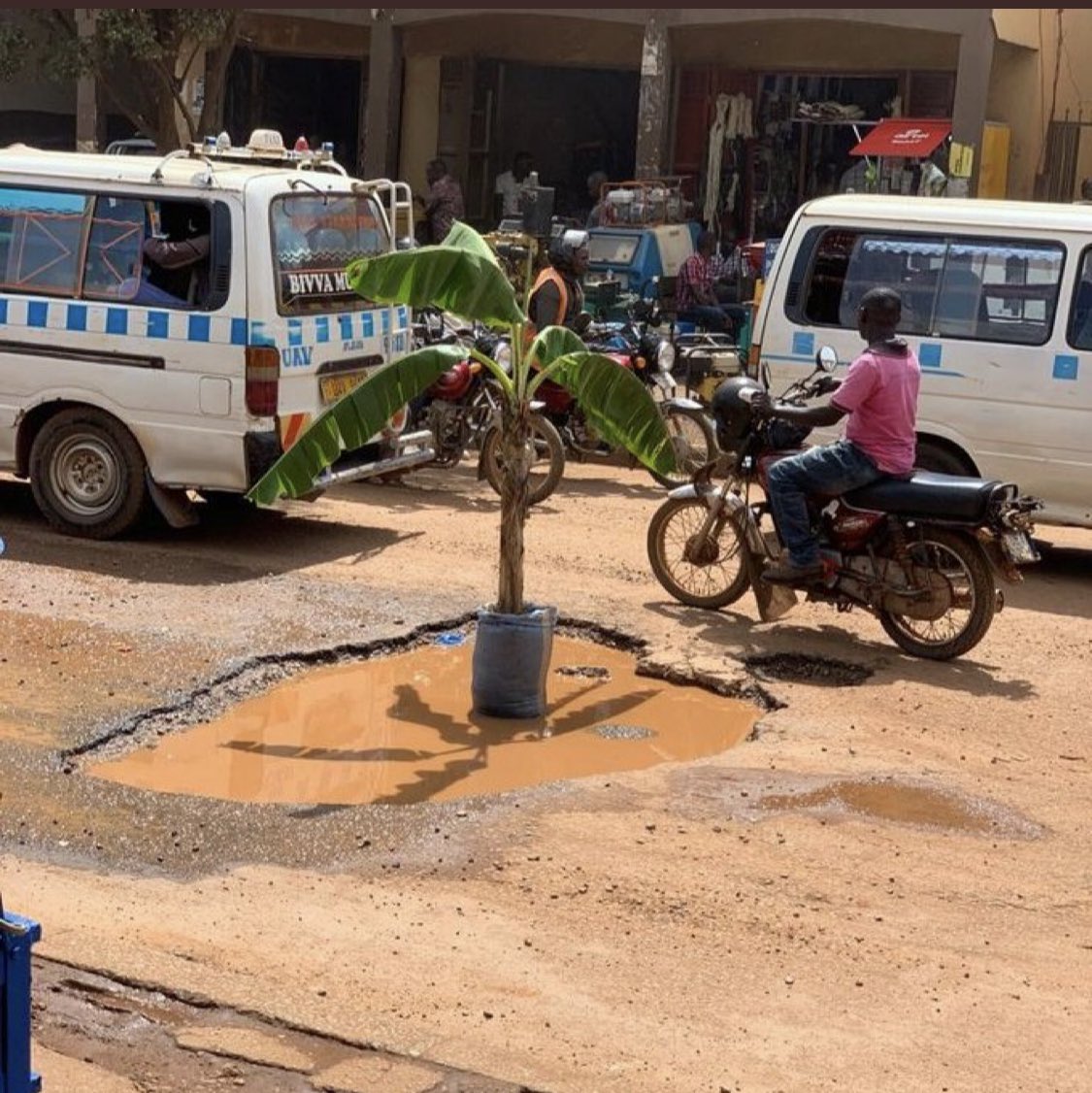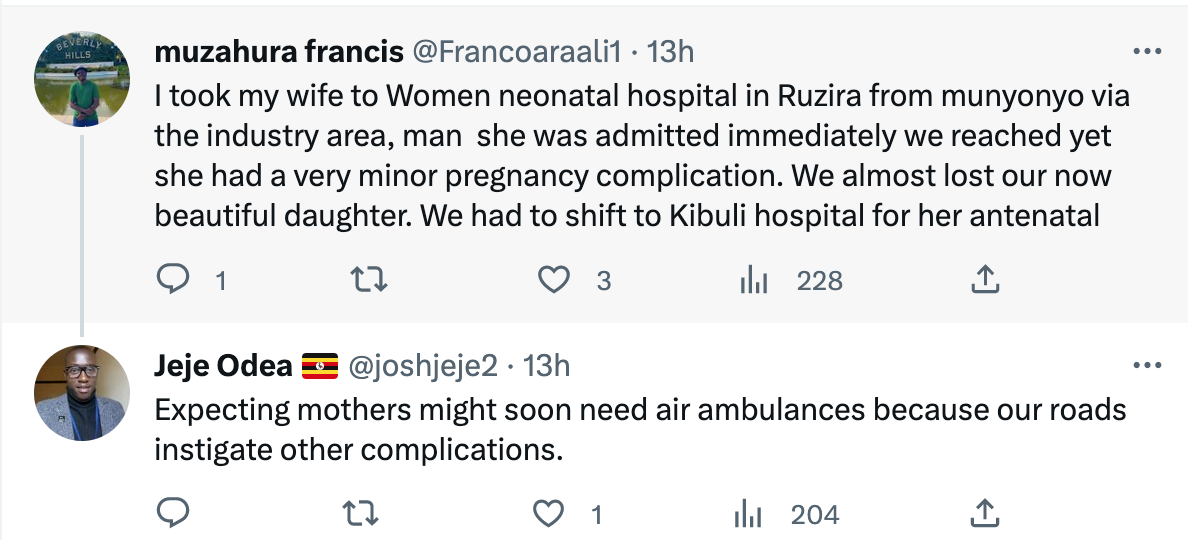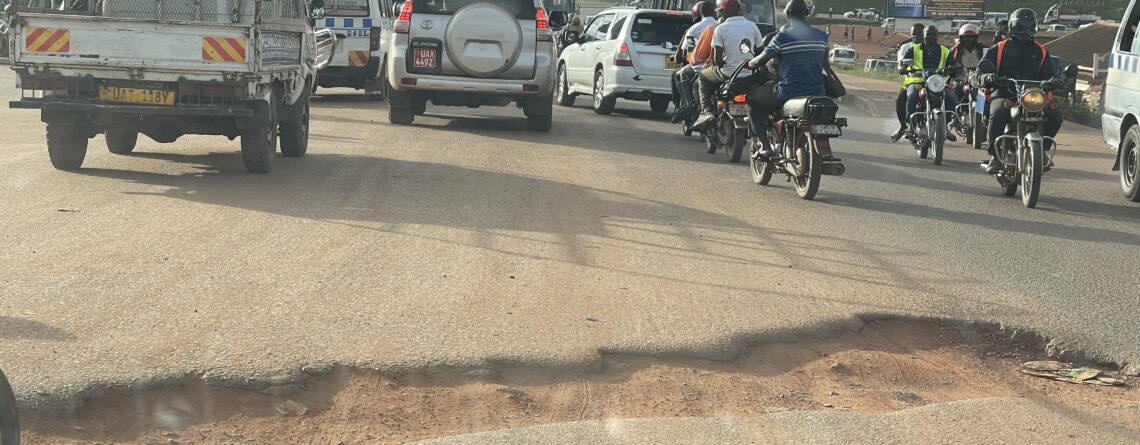Uganda’s Potholes: Pregnant Mothers count losses

By Culton Scovia Nakamya
At about 4:00pm on April 1, 2023, Zurah Nakiryowa a resident of Kiwafu Zone in Makindye Division, Kampala suddenly started screaming loud for everyone to notice that the pregnant mother had finally gotten her labor pains and was due for delivery.
With her savings, she reached out to one of the car hiring companies in her neighborhood and within no time, Nakiryowa was ready to head to Kisenyi Health Centre IV for further management.
The most terrifying moments were maneuvering the bumpy Salaama Road that is punctuated by potholes fit to be called latrines. Through the Namasole road, in Makindye, she would have to connect Kibuye at Entebbe Road then proceed to Kisenyi for 10km.
Her driver was held between a rock and a hard place, he had to make sure he drives carefully through the potholed road but also ensure that her client gets to her destination in time for safe delivery. This did was never going to be possible because it took Nakiryowa 2 hours to reach her destination in a journey that should have taken her less than 30 minutes.
Alas, upon arrival at the facility, before getting out of the car, Nakiryowa felt her unborn baby popping out and just at the entrance of Kisenyi Health Centre IV, she asked the driver to open her maama kit, pick her body wrap and a piece of polythene.
“The potholes had hit me so bad and made me delay to reach the health facility. Unfortunately, I couldn’t walk so I only needed to get out of the car. I felt the baby had already got out. I felt him in my thighs so I didn’t care about privacy. I was helped with a plastic sheet and the baby got out. Nurses and midwives rushed for assistance and saved both the baby and myself”. Recalls Nakiryowa.

Nakiryowa’s experience is one of the risky encounters health service providers struggle to fight being categorized as the second delay, it can easily lead to maternal mortality.
The potholes on almost every route in Kampala and other parts of the country have become a big challenge to the expectant mothers and those under antenatal care and in due course of delivery which has created much tension among pregnant mothers.
Statistics
In Uganda’s Capital Kampala, Nakiryowa’s predicament of finding maternity health care is shared by over 70 per cent of the women especially those that leave in slum areas.
At least 40 babies are delivered every day at Kawempe National Referral Hospital according to current updates from Ministry of health.
According to the Annual Health Sector Performance report 2021/2022, 1,446,894 deliveries were conducted of which 1,226 were maternal deaths registered across the country. This translates into a Maternal mortality rate of 85/100,000 deliveries.
Uganda has registered an increase in maternal mortality rates in the last two financial years compared to the past. This is the same period Mothers have experienced the worst while traveling to health facilities to receive their bundles of joy.
At least 1,102 deaths were registered in 2019/2020, 1,228 registered in 2020/2021 and 1,226 registered in 2021/2022. Referrals and large not for profit hospitals registered the highest maternal deaths with a 4% increase from the previous year. The same Health facilities are located in urban and peri urban areas with the worst state of roads.
The report indicates that Kampala alone, registered 196 maternal deaths out of 87,966 deliveries done at different facilities. North central and south central followed with 122 deaths each during the financial year 2021/2022.
Maternal deaths in Uganda are largely attributed to Haemorrhage accounting for up to 41% of deaths registered in the FY 2021/22. Hypertensive disorders of pregnancy follow at 14% while obstructed / prolonged labour accounts for 3%.
Sharing experience
Dr. Sylvia Nakitto, a senior midwife at Kawempe Referral Hospital says the potholes have led to delay in the process of child birth for many mothers especially in places where ambulances no longer work effectively like it was before.
“The biggest cause of car congestion on roads is the poor condition in which they are. Our facility faces problems of mothers giving birth in corridors and on verandahs at least every week. Sometimes we try to ask the caretakers why they didn’t respond after seeing situations worsen, they claim to have delayed along the way due to poor access roads.” Says Dr. Nakitto.
Dr. Nakitto adds that they have had cases of pregnant women who come with bleeding placentas, some dangling out of their private parts and in the process the pregnancy is lost while other suffer high blood pressure and stress to death.
 A pregnant woman who has preferred anonymity to speak comfortably in this story says she fell off the boda boda while traveling to Kawempe National Referral Hospital for her third trimester antenatal visit. The accident was a result of the bodaboda rider dodging a pothole within Kawempe division which resulted into bleeding.
A pregnant woman who has preferred anonymity to speak comfortably in this story says she fell off the boda boda while traveling to Kawempe National Referral Hospital for her third trimester antenatal visit. The accident was a result of the bodaboda rider dodging a pothole within Kawempe division which resulted into bleeding.
“I was about to reach the second round about, just before the police station, where my boda rider fell into a pothole. I accidentally slid off the bodaboda and I hurt my elbow. Doctors say I got implications, and since then I keep on bleeding oftenly, however I’m receiving enough medication and I hope to be better,” she narrates tearfully.
Joselyn Nalujja another senior midwife at Jinja Regional Referral Hospital says the situation is not any better in that part of the country indicating that any safe delivery must avoid three delays.
“The delay in decision to seek medical care, delay to get to a health facility and the delay to receive adequate health care,” Nalujja says the second delay adding, “Which is a result of mobility challenges due to the state of roads affects delivery.”
During the last stages of pregnancy, she says, the bottom part of the uterus bulges to accommodate the growing baby, any mobility challenges can easily lead to placenta abruption, one of the causes of heamorrhage.
Dr. Musana Othniel a senior Gynecologist says safe delivery begins with easy access and passage for any mother. “Those potholes can cause trauma and injuries to the uterus. if a mother is moving in a very bumpy road, the placenta can tear off the uterus. This is what we call placenta abruption. If you get tears in the uterus, the amniotic sack raptures and the baby just pops out.”
If the pregnant woman experiences placenta abruption and the baby doesn’t pop out, sometimes, the placenta bleeds which leads to heamorrhage.
Dr. Musana’s explanation proves a reason why Nakiryowa had a risky delivery at the entrance of Kisenyi Health Centre IV.
Dr. Musana adds that women who have previously delivered using cesarean section and are due for another delivery are susceptible to lethal complications. “If she has a weak scar, and uses a bumpy road. it can easily tear .”
The trigger
On 17th April, Ugandans especially in Kampala launched an online campaign as a wake call to improve the state of roads in the city. Dubbed the #KampalaPotholeExhibition, the campaign has since attracted more than 100,000 posts.
“Take as many Kampala pothole photos and videos as you can to equip yourself for the #KampalaPotholeExhibition starting online tomorrow.” Announced Dr. Jimmy Ssentongo (Spire) a renown cartoonist and educationist.
This has seen netizens share images of potholes of every size and shape in the different parts of the city. Pregnant netizens have expressed how the potholes affect them differently.
“Yesterday I hit one of those potholes along Ntinda Kyambogo road, kakye omwana muzare (I nearly delivered the baby)” Posted Mackline Asiimire.
“This one is not a pothole; it is a pond. In Kampala, we do not drive on the left, we drive on what is left”.

The campaign has moved from posting potholes to satirical, later to online placards calling on government to fix the roads.
While many online protestors express mobility challenges, high cost of vehicle maintenance and discomforts, little attention has been given to how the poor state of roads has affected mothers differently.

Different government officials have reacted to the #KampalaPotholeExhibition, some attacking protestors for putting the country’s image before tourists at stake, while others agree that the situation is beyond patience.
“We have potholes of every design, every size, the beautiful ones, the ugly ones, the deep ones, the shallow ones and the wide and narrow ones. They are all in Kampala”. Thomas Tayebwa, the deputy Speaker of Parliament.

Interventions
Kampala Capital City Authority (KCCA) has mapped 85,000 square meters of potholes by December 2022 but no hope in sight after the city authority announced they are low on road maintenance budgets.
Dorothy Kisaka, the Executive Director KCCA says the authority requires between 70bn -100bn but government has only allocated 26bn annually.
President Museveni has since directed the ministry of finance to release Ugx6bn to facilitate filling of potholes in the capital city.
While Kampala mothers in Kampala might get some relief influenced by the #KampalaPotholeExhibition, other parts of the country are likely to remain the same.
Joselyne Nalujja a senior midwife advises pregnant women to seek accommodation near facilities where they are set to have their delivery from, prior to their date of delivery. But Dr. Othiniel Musana says if such accommodation arrangements can’t be met, pregnant women who are due for delivery should ignore their preferred delivery facility and seek assistance from any nearby facility. “If you have a personal doctor, still use the nearby facility as you get in touch with them to get you from there than risking,” says Musana.



Leave a Reply